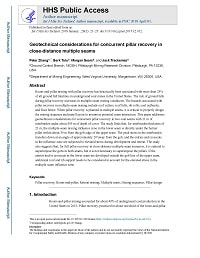Mining Publication: Geotechnical Considerations for Concurrent Pillar Recovery in Close-distance Multiple Seams
Original creation date: January 2018
Authors: Y Zhang, I Tulu, M Sears, J Trackemas
Room-and-pillar mining with pillar recovery has historically been associated with more than 25% of all ground fall fatalities in underground coal mines in the United States. The risk of ground falls during pillar recovery increases in multiple-seam mining conditions. The hazards associated with pillar recovery in multiple-seam mining include roof cutters, roof falls, rib rolls, coal outbursts, and floor heave. When pillar recovery is planned in multiple seams, it is critical to properly design the mining sequence and panel layout to minimize potential seam interaction. This paper addresses geotechnical considerations for concurrent pillar recovery in two coal seams with 21 m of interburden under about 305 m of depth of cover. The study finds that, for interburden thickness of 21 m, the multiple-seam mining influence zone in the lower seam is directly under the barrier pillar within about 30 m from the gob edge of the upper seam. The peak stress in the interburden transfers down at an angle of approximately 20° away from the gob, and the entries and crosscuts in the influence zone are subjected to elevated stress during development and retreat. The study also suggests that, for full pillar recovery in close-distance multiple-seam scenarios, it is optimal to superimpose the gobs in both seams, but it is not necessary to superimpose the pillars. If the entries and/or crosscuts in the lower seam are developed outside the gob line of the upper seam, additional roof and rib support needs to be considered to account for the elevated stress in the multiple-seam influence zone.

- Damage Delineation in Structures Using Laser Vibrometry and Remote Excitation
- Deep Cover Pillar Recovery in the US
- Developments in Sealant Support Systems for Ground Control
- Major Hazard Risk Assessment Applied to Pillar Recovery Operations
- Multiple Seam Mining Interactions: Case Histories from the Harris No. 1 Mine
- Multiple-Seam Mining in the United States: Background
- Multiple-Seam Mining Interactions: Case Histories from the Harris No. 1 Mine
- Proceedings: New Technology for Ground Control in Retreat Mining
- Sizing of Final Stumps for Safer Pillar Extraction
- Time-Lapse Tomography of a Longwall Panel: A Comparison of Location Schemes